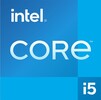AMD Ryzen 5 5560U vs Intel Core i5-1240P vs AMD Ryzen 3 5400U
AMD Ryzen 5 5560U
► remove from comparison
The AMD Ryzen 5 5560U, is a fairly fast Cezanne family processor designed for use in thinner, lighter laptops. The R5 5560U integrates six of the eight cores based on the Zen 3 microarchitecture. The cores are clocked at 2.3 (guaranteed base clock) to 4 GHz (Turbo) and support SMT for a total of 12 threads. The chip is manufactured on the modern 7 nm TSMC process.
The new Zen 3 microarchitecture offers a significantly higher IPC (instructions per clock) compared to Zen 2. For desktop processors AMD claims 19 percent on average and in applications reviews showed around 12% gains at the same clock speed.
In addition to the six CPU cores, the APU also integrates a Radeon RX Vega 6 integrated graphics card with 6 CUs at up to 1600 MHz. The dual channel memory controller supports DDR4-3200 and energy efficient LPDDR4-4266 RAM. Furthermore, 16 MB level 3 cache (up from 8 MB at the 4800U) can be found on the chip.
Performance
The Ryzen 5 is a solid upper mid-range CPU and should be only slightly slower than the Ryzen 5 5600U (+200 MHz Boost).
Power consumption
This Ryzen 5 has a default TDP of 15 W, a value that laptop makers are allowed to change to anything between 10 W and 25 W with clock speeds and performance changing accordingly as a result. By going for the lowest value possible, it is possible to build a passively cooled system around this chip. Most laptop makers, however, will do the opposite to maximize performance.
The AMD Ryzen 5 5560U is built with TSMC's 7 nm manufacturing process for average, as of mid 2023, energy efficiency.
Intel Core i5-1240P
► remove from comparison
The Intel Core i5-1240P is a mid-range Alder Lake-P family SoC designed for use in ultra-light, ultra-thin (yet actively cooled) laptops. It was announced in early 2022 and it has 4 performance cores as opposed to the 6 cores of the top-of-the-line i7-1280P (P-cores, Golden Cove architecture) mated to 8 efficient cores (E-cores, Gracemont architecture). The i5's P-cores are Hyper-Threading-enabled for a total of 16 threads when combined with its E-cores. The clock speeds range from 1.7 GHz to 4.4 GHz for the performance cluster and 1.2 GHz to 3.3 GHz for the efficient cluster. The shortcomings of this processor as compared with the slightly faster Core i5-1250P include the slightly lower iGPU clock speed and the limited vPro feature set ("Essentials" tier only, not allowing for remote device management).
Architecture
The i5 is a continuation of Intel's efforts to use the ARM-developed big.LITTLE technology for its own benefit. A single "little" Alder Lake core is supposed to be as fast as a Skylake core (as found in the venerable Core i7-6700HQ among other options) which is six years old at this point. All of Core i5-1240P's CPU cores enjoy access to 12 MB of L3 cache. The integrated memory controller supports various memory types up to LPDDR5-5200, DDR5-4800, LPDDR4x-4267 or DDR4-3200; Intel recommends using no more than 64 GB of RAM, for reference. Just like the other 12th Gen Intel Core processors, this Core i5 comes with the Thread Director which is a new functionality designed to help Windows 11 decide which cores to use for what workload for best performance and efficiency possible. Hardware acceleration of AI algorithms is supported via GNA 3.0 and DL Boost (via AVX2). PCI-Express 5.0 support has not found its way into Alder Lake P processors, so users will have to be content with PCI-Express 4.0 for the time being. Four PCI-Express 4 lanes allow for a read/write rate of up to 7.9 GB/s, provided a suitably fast NVMe SSD is used.
Please note this is not a user-replaceable CPU. It gets soldered permanently on to the motherboard (FCBGA1744 socket interface).
Performance
Multi-thread performance is most comparable to the Ryzen 5 5500U, Ryzen 5 5600U and, surprisingly enough, the Core i5-1250P, making the i5-1240P a great processor for most consumers. Content creators and gamers will be better served by an H-class CPU such as the mighty Core i7-12700H, though.
Thanks to its decent cooling solution and a long-term CPU power limit of 40 W, the NUC 12 Pro Kit NUC12WSBi5 is among the fastest systems built around the 1240P that we know of. It can be more than 2 times as fast in CPU-bound workloads as the slowest system featuring the same chip in our database, as of August 2023.
Graphics
The built-in graphics adapter in the form of the 80 EU Iris Xe running at up to 1.3 GHz has seen little change from what was built into certain Tiger Lake-UP3 processors, like an i5-1135G7, which is hardly a downside as this iGPU is loaded with modern features such as AV1 video decoding capability and SUHD 4320p monitor support. You can use up to 4 monitors simultaneously with this GPU, provided the laptop has the outputs required. The Xe isn't a stranger to a bit of casual gaming; that said, your mileage may vary depending on how high the Power Limits are and how capable the cooling solution of a laptop is. Expect something close to NVIDIA's MX250 or in other words, acceptable framerates in most games when playing at 1080p / Low settings. Fast RAM is a prerequisite for decent performance as the Iris Xe has to make do with no dedicated video memory.
Power consumption
The i5's base power consumption (also known as the default TDP value or Power Limit 1) is 28 W; its maximum Turbo power consumption (also known as the PL2) is not supposed to exceed 64 W. The "Minimum Assured" power consumption is fairly high at 20 W. All in all, an active cooling solution is a must for a CPU like this.
This 12th generation Intel chip is built with Intel's fourth-gen 10 nm process marketed as Intel 7 for decent, as of late 2022, energy efficiency. Keep in mind that many 7 nm U-class AMD Ryzen 5000 chips are just as fast, or even faster than the i5 while sipping less juice.
AMD Ryzen 3 5400U
► remove from comparison
The AMD Ryzen 3 5400U is a processor for thin and light laptops based on the Cezanne generation. The R3 5400U integrates four of the eight cores based on the Zen 3 microarchitecture and is the slowest U-series processor of the Cezanne generation at launch. The cores are clocked at 2.6 (guaranteed base clock) to 4 GHz (Turbo) and support SMT / Hyperthreading (8 threads). The chip is manufactured in the modern 7 nm process at TSMC.
The new Zen 3 microarchitecture offers a significantly higher IPC (instructions per clock) compared to Zen 2. For desktop processors AMD claims 19 percent on average and in applications reviews showed around 12% gains at the same clock speed.
Performance
While we have not tested a single system built around the 5400U as of August 2023, we are fairly confident the chip is a little faster than the Ryzen 3 5300U and its four Zen 2 cores running at clock speeds similar to what the 5400U has. Naturally, your mileage may vary depending on how competent the cooling solution of your laptop is and how high the CPU power limits are.
In addition to the four CPU cores, the APU also integrates a Radeon RX Vega 6 integrated graphics card with 6 CUs and up to 1600 MHz. The dual channel memory controller supports DDR4-3200 and energy efficient LPDDR4-4266 RAM. Furthermore, 8 MB level 3 cache (same as the old 4800U) can be found on the chip.
Power consumption
This Ryzen 3 has a default TDP (also known as the long-term power limit) of 15 W. Laptop manufacturers are free to change that value to anything between 10 W and 25 W if so desired, with clock speeds and performance changing correspondingly. Those values aren't low enough to allow for passively cooled designs.
This is a 7 nm chip; it thus has higher-than-average, as of late 2022, energy efficiency.
| Model | AMD Ryzen 5 5560U | Intel Core i5-1240P | AMD Ryzen 3 5400U | ||||||||||||||||||||||||||||||||||||||||||||||||||||||||
| Codename | Cezanne-U (Zen 3) | Alder Lake-P | Cezanne-U (Zen 3) | ||||||||||||||||||||||||||||||||||||||||||||||||||||||||
| Series | AMD Cezanne (Zen 3, Ryzen 5000) | Intel Alder Lake-P | AMD Cezanne (Zen 3, Ryzen 5000) | ||||||||||||||||||||||||||||||||||||||||||||||||||||||||
| Series: Cezanne (Zen 3, Ryzen 5000) Cezanne-U (Zen 3) |
|
|
| ||||||||||||||||||||||||||||||||||||||||||||||||||||||||
| Clock | 2300 - 4000 MHz | 1200 - 4400 MHz | 2600 - 4000 MHz | ||||||||||||||||||||||||||||||||||||||||||||||||||||||||
| L1 Cache | 384 KB | 1.1 MB | 256 KB | ||||||||||||||||||||||||||||||||||||||||||||||||||||||||
| L2 Cache | 3 MB | 10 MB | 2 MB | ||||||||||||||||||||||||||||||||||||||||||||||||||||||||
| L3 Cache | 16 MB | 12 MB | 8 MB | ||||||||||||||||||||||||||||||||||||||||||||||||||||||||
| Cores / Threads | 6 / 12 | 12 / 16 | 4 / 8 | ||||||||||||||||||||||||||||||||||||||||||||||||||||||||
| TDP | 25 Watt | 28 Watt | 25 Watt | ||||||||||||||||||||||||||||||||||||||||||||||||||||||||
| Technology | 7 nm | 10 nm | 7 nm | ||||||||||||||||||||||||||||||||||||||||||||||||||||||||
| max. Temp. | 105 °C | 100 °C | 105 °C | ||||||||||||||||||||||||||||||||||||||||||||||||||||||||
| Socket | FP6 | BGA1744 | FP6 | ||||||||||||||||||||||||||||||||||||||||||||||||||||||||
| Features | DDR4-3200/LPDDR4-4266 RAM, PCIe 3, MMX, SSE, SSE2, SSE3, SSSE3, SSE4A, SSE4.1, SSE4.2, AVX, AVX2, BMI2, ABM, FMA, ADX, SMEP, SMAP, SMT, CPB, AES-NI, RDRAND, RDSEED, SHA, SME | DDR4-3200/LPDDR4x-4266/DDR5-4800/LPDDR5-5200 RAM, PCIe 4, Thread Director, DL Boost, GNA, MMX, SSE, SSE2, SSE3, SSSE3, SSE4.1, SSE4.2, AVX, AVX2, BMI2, ABM, FMA, ADX, SMEP, SMAP, EIST, TM1, TM2, Hyper-Threading, Turbo, SST, AES-NI, RDRAND, RDSEED, SHA | DDR4-3200/LPDDR4-4266 RAM, PCIe 3, MMX, SSE, SSE2, SSE3, SSSE3, SSE4A, SSE4.1, SSE4.2, AVX, AVX2, BMI2, ABM, FMA, ADX, SMEP, SMAP, SMT, CPB, AES-NI, RDRAND, RDSEED, SHA, SME | ||||||||||||||||||||||||||||||||||||||||||||||||||||||||
| iGPU | AMD Radeon RX Vega 6 (Ryzen 4000/5000) ( - 1600 MHz) | Intel Iris Xe Graphics G7 80EUs ( - 1300 MHz) | AMD Radeon RX Vega 6 (Ryzen 4000/5000) ( - 1600 MHz) | ||||||||||||||||||||||||||||||||||||||||||||||||||||||||
| Architecture | x86 | x86 | x86 | ||||||||||||||||||||||||||||||||||||||||||||||||||||||||
| Announced | |||||||||||||||||||||||||||||||||||||||||||||||||||||||||||
| Manufacturer | www.amd.com | ark.intel.com | www.amd.com |
Benchmarks
Average Benchmarks AMD Ryzen 5 5560U → 100% n=2
Average Benchmarks Intel Core i5-1240P → 130% n=2
Average Benchmarks AMD Ryzen 3 5400U → 70% n=2
* Smaller numbers mean a higher performance
1 This benchmark is not used for the average calculation












